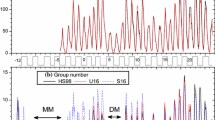Abstract
THE detection rate of solar neutrinos is significantly below the value predicted by contemporary theories of solar structure and evolution1,2. The most likely—or at least best advertised—explanation of the discrepancy is episodic and probably periodic core expansion in the Sun3; in the models developed to date, mixing of 3He, produced by the p–p process, is the initiating event4–7. Although the radiative transfer time scale of photons from the core to the photosphere of the Sun is long, all the models identify epochs of anomalously low neutrino flux with epochs of anomalously low surface luminosity; and the temptation to connect the present “ice age” on Earth with low solar luminosity, L, has been unsuccessfully resisted. The peak-to-peak variations in L, δL/L, range from about 7% to about 35% in these models, enough to have significant climatological consequences (see, for example, ref. 8). The duration of the variation is roughly the Kelvin–Helmholtz time scale ∼107 yr; to correspond to the principal glaciation period, the interval between mixings must be ∼2.5 × 108 yr.
Similar content being viewed by others
References
Davis, R., Rogers, L. C., and Radeka, V., Bull. Amer. Phys. Soc., 16, 631 (1971).
Bahcall, J. N., and Sears, R. L., Ann. Rev. Astron. Astrophys., 10, 25 (1972).
Fowler, W. A., Nature, 238, 4 (1972).
Rood, R. T., Nature Physical Science, 240, 178 (1972).
Ezer, D., and Cameron, A. G. W., Nature Physical Science, 240, 180 (1972).
Dilke, F. W. W., and Gough, D. O., Nature, 240, 262 (1972).
Cameron, A. G. W., Rev. Geophys. Space Phys. (in the press).
Faegre, A., J. Appl. Meteorology, 11, 4 (1972).
Sagan, C., Icarus, 15, 511 (1971).
Steinbacker, R. H., Kliore, A., Lorell, J., Hipsher, H., Barth, C. A., Masursky, H., Münch, G., Pearl, J., and Smith, B., Science, 175, 294 (1972).
Sagan, C., Astronaut. Aeronaut., 10, 26 (1972).
Johnson, H. L., Astrophys. J., 116, 640 (1952).
Author information
Authors and Affiliations
Rights and permissions
About this article
Cite this article
SAGAN, C., YOUNG, A. Solar Neutrinos, Martian Rivers, and Praesepe. Nature 243, 459–460 (1973). https://doi.org/10.1038/243459a0
Received:
Published:
Issue Date:
DOI: https://doi.org/10.1038/243459a0
- Springer Nature Limited
This article is cited by
-
Solar Rotation and the Neutrino Flux
Nature Physical Science (1973)
-
Praesepe and the Solar Neutrino Problem
Nature (1973)





